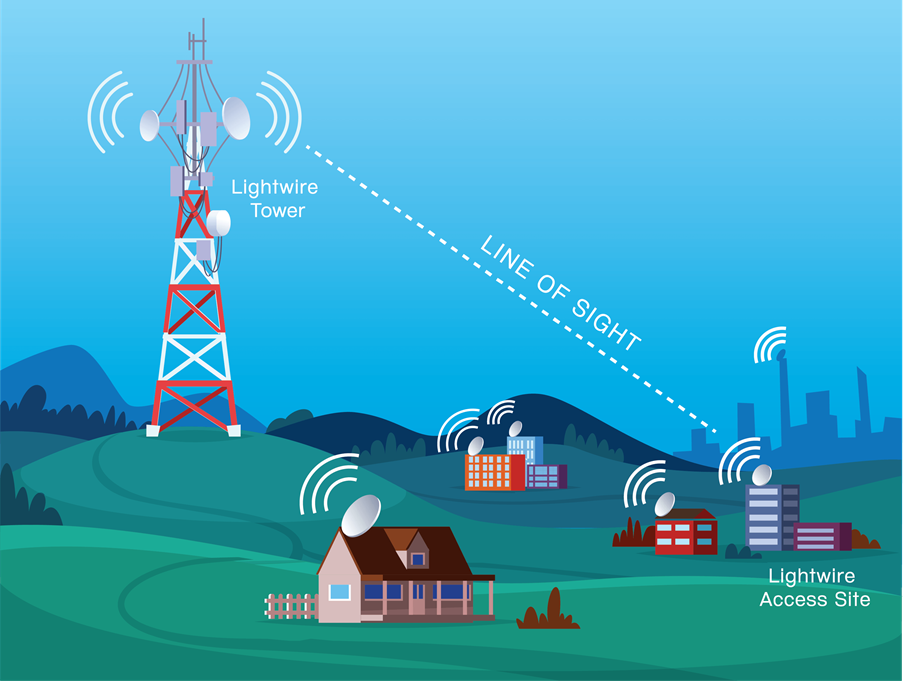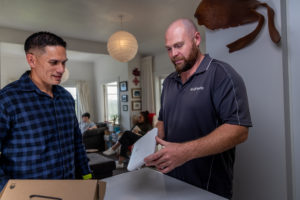You’ve probably asked yourself, “How come my neighbour’s internet seems faster than mine? Why is the internet slower in the afternoon?”. Let’s unpack some of this. Speed and uptime are the most important factors in determining the quality of an internet connection. In this blog, we’ll focus on speed.
Lightwire provides fixed wireless internet services, and speed isn’t a simple or consistent thing in the wireless world (we’ll explain why soon).
Fibre, on the other hand, is simple. It’s sold based on the maximum attainable speed of each connection. When buying a fibre internet service, you will have options such as 100/100Mbps or 500/500Mbps to choose from (the first number representing download, the second is upload), which is possible because every connection is subject to the same limitations.
Read here to learn why there isn’t more fibre in rural areas.
Fixed wireless connections are very different. They operate by sending signals from a dish on a high site (or tower) on a nearby hill to the dish on the roof of your house.
Here’s what a standard connection looks like:

What will determine the maximum speeds you can get with rural internet?
There are many things that play some part in the overall speed of your internet. What we can control, we ensure to give you the best experience we can, but what we can’t, we try managing the best we can:
Distance
The distance between your house and the tower you are connecting to matters. The further away, the worse the signal. The worse the signal, the worse the speed. To ensure we meet our guaranteed speeds (more on those later), we don’t connect services that are located more than 20km from a tower.
Interference
If another service (a neighbours internet connection, a WiFi security system, a drone, or any number of other things) is using the same wireless frequency, then it could impact your speeds. These services will compete for space on the frequency used by your connection, limiting its effectiveness. So, if you’re streaming off multiple devices throughout the house, don’t be surprised if it’s impacting you speed.
Line of sight
Many speed complaints are often found to be due to a tree growing in between the dish on a customer’s roof and the high site. Fixed wireless can’t go through objects, so it needs a clear path to operate in. Any obstruction will severely impact connection stability and speed.
The number of connections on a sector
Each high site on our network has multiple sectors, each of those being a radio/dish that is pointing in a specific direction. If too many services are connected to a single sector, the maximum speeds of the users on that sector will be limited. That’s why we consistently add sectors to our network and build new high sites to ensure this is rarely an issue. We are serious about limiting congestion on our network wherever possible. I mean, we invested over $12 million into our network over the last 3 years…
Backhaul from the high site
High sites needs to connect back to our core network via fibre and then to the rest of the world. The problem is that these high sites are typically in very remote areas, so it can be tough to get fibre to them. While we are investing $5 million into the network over the next 2 years to run fibre to as many towers as possible, we will still have a number of sites with licensed and unlicensed wireless backhaul. Fibre fed high sites are able to provide connected customers with faster speeds, and can scale to greater speeds as more customers connect.
The Lightwire Speed Guarantee
We can’t guarantee the world with all of these variables in play. We know that our median download speed at the time of installation over the last 30 days (for over 200 new installs) is 48Mbps, but we can’t guarantee every customer will get that. Some will get more; some will get less.
When writing this, Lightwire is the only wireless internet service provider that offers a minimum speed guarantee.
During off-peak periods, we commit to providing a minimum download speed of 20Mbps, and during peak times, we commit to providing a minimum download speed of 10Mbps.
“On-peak” is defined as 3 pm through to 10 pm. Essentially, the period when the kids are home, where the family is streaming Netflix, gaming, and other internet hungry options.
Your speed guarantee means that any experience that falls short of this promise justifies the lodgement of a support case.
If an issue exists, we will ask you to measure the download speed from your Lightwire supplied router, ideally via a device connected to it via ethernet (directly into the router). If this is not possible, a portable device connected via wireless and positioned near the router is the next best option.
Our support team will work with you to isolate any potential complicating factors such as WiFi coverage or 3rd party equipment from the mix so that we can focus on the performance of your connection. They’ll ask you to run speed tests to our server and will look at a range of other diagnostic reports to resolve the issue.
On very (very) rare occasions, due to 3rd party interference, for example, we may not be able to get your speeds to where we want them to be, but in such cases, we will not apply any early termination charges if you are in contract and choose to cancel your service. We can’t always control speed outcomes, but we will take it on the chin if that’s the case.


